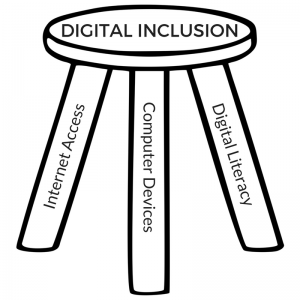
Digital Inclusion refers to the activities necessary to ensure that all individuals and communities, including the most disadvantaged, have access to and use of Information and Communication Technologies (ICTs). This includes 5 elements:
- affordable, robust broadband internet service;
- internet-enabled devices that meet the needs of the user;
- access to digital literacy training;
- quality technical support;
- applications and online content designed to enable and encourage self-sufficiency, participation and collaboration. Digital Inclusion must evolve as technology advances.
Digital Inclusion requires intentional strategies and investments to reduce and eliminate historical, institutional and structural barriers to access and use technology.
The results of Digital Inclusion leads to Digital Equity.
Digital Equity is a condition in which all individuals and communities have the information technology capacity needed for full participation in our society, democracy and economy. Digital Equity is necessary for civic and cultural participation, employment, lifelong learning, and access to essential services.
The definition of Digital Inclusion and Digital Equity come from the National Digital Inclusion Alliance (NDIA), an organization that provides a unified voice for home broadband access, public broadband access, personal devices and local technology training and support programs.